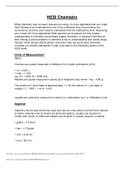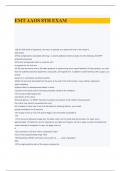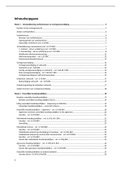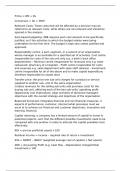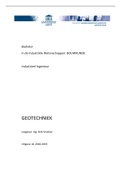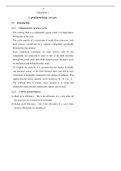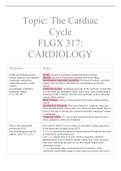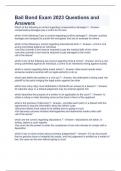ANATOMY AND PHYSIOLOGY
HEPATOBILLARY TREE
ANATOMY OF THE GALLBLADDER:
Gallbladder, muscular organ that serves as a reservoir for bile, present in most vertebrates. In
humans, it is a pear-shaped membranous sac on the undersurface of the right lobe of the liver just
below the lower ribs. It is generally about 7.5 cm (about 3 in) long and 2.5 cm (1 in) in diameter at its
thickest part; it has a capacity varying from 1 to 1.5 fluid ounces. The body (corpus) and neck (collum)
of the gallbladder extend backward, upward, and to the left. The wide end (fundus) points downward
and forward, sometimes extending slightly beyond the edge of the liver. Structurally, the gallbladder
consists of an outer peritoneal coat (tunica serosa); a middle coat of fibrous tissue and unstriped
muscle (tunica muscularis); and an inner mucous membrane coat (tunica mucosa).
PHYSIOLOGY OF THE GALLBLADDER:
The function of the gallbladder is to store bile, secreted by the liver and transmitted from that
organ via the cystic and hepatic ducts, until it is needed in the digestive process. The gallbladder,
when functioning normally, releases bile through the biliary ducts into the duodenum to aid digestion
by promoting peristalsis and absorption, preventing putrefaction, and emulsifying fat.
Function of liver
The liver has many functions. Some of the functions are: to produce substances that
break down fats, convert glucose to glycogen, produce urea (the main substance of
urine), make certain amino acids (the building blocks of proteins), filter harmful
substances from the blood (such as alcohol), storage of vitamins and minerals (vitamins
, A, D, K and B12) and maintain a proper level or glucose in the blood. The liver is also
responsible fore producing cholesterol. It produces about 80% of the cholesterol in your
body.
Function of gall bladder
The function of the gallbladder is to store bile and concentrate. Bile is a digestive
liquid continually secreted by the liver. The bile emulsifies fats and neutralizes acids in
partly digested food. A muscular valve in the common bile duct opens, and the bile flows
from the gallbladder into the cystic duct, along the common bile duct, and into the
duodenum (part of the small intestine).
Function of duodenum
The duodenum is largely responsible for the breakdown of food in the small
intestine. Brunner's glands, which secrete mucus, are found in the duodenum. The
duodenum wall is composed of a very thin layer of cells that form the muscularis
mucosae. The duodenum is almost entirely retroperitoneal. The pH in the duodenum is
approximately six. It also regulates the rate of emptying of the stomach via hormonal
pathways.
Function of pancreas
The pancreas is a small organ located near the lower part of the stomach and the
beginning of the small intestine. This organ has two main functions. It functions as an
exocrine organ by producing digestive enzymes, and as an endocrine organ by producing
hormones, with insulin being the most important hormone produced by the pancreas.
The pancreas secretes its digestive enzymes, through a system of ducts into the digestive
tract, while it secretes its variety of hormones directly into the bloodstream.
Abnormal pancreatic function can lead to pancreatitis or diabetes mellitus.
Function of cystic duct
Bile can flow in both directions between the gallbladder and the common hepatic
duct and the (common) bile duct. In this way, bile is stored in the gallbladder in between
meal times and released after a fatty meal.
Function of transverse colon
HEPATOBILLARY TREE
ANATOMY OF THE GALLBLADDER:
Gallbladder, muscular organ that serves as a reservoir for bile, present in most vertebrates. In
humans, it is a pear-shaped membranous sac on the undersurface of the right lobe of the liver just
below the lower ribs. It is generally about 7.5 cm (about 3 in) long and 2.5 cm (1 in) in diameter at its
thickest part; it has a capacity varying from 1 to 1.5 fluid ounces. The body (corpus) and neck (collum)
of the gallbladder extend backward, upward, and to the left. The wide end (fundus) points downward
and forward, sometimes extending slightly beyond the edge of the liver. Structurally, the gallbladder
consists of an outer peritoneal coat (tunica serosa); a middle coat of fibrous tissue and unstriped
muscle (tunica muscularis); and an inner mucous membrane coat (tunica mucosa).
PHYSIOLOGY OF THE GALLBLADDER:
The function of the gallbladder is to store bile, secreted by the liver and transmitted from that
organ via the cystic and hepatic ducts, until it is needed in the digestive process. The gallbladder,
when functioning normally, releases bile through the biliary ducts into the duodenum to aid digestion
by promoting peristalsis and absorption, preventing putrefaction, and emulsifying fat.
Function of liver
The liver has many functions. Some of the functions are: to produce substances that
break down fats, convert glucose to glycogen, produce urea (the main substance of
urine), make certain amino acids (the building blocks of proteins), filter harmful
substances from the blood (such as alcohol), storage of vitamins and minerals (vitamins
, A, D, K and B12) and maintain a proper level or glucose in the blood. The liver is also
responsible fore producing cholesterol. It produces about 80% of the cholesterol in your
body.
Function of gall bladder
The function of the gallbladder is to store bile and concentrate. Bile is a digestive
liquid continually secreted by the liver. The bile emulsifies fats and neutralizes acids in
partly digested food. A muscular valve in the common bile duct opens, and the bile flows
from the gallbladder into the cystic duct, along the common bile duct, and into the
duodenum (part of the small intestine).
Function of duodenum
The duodenum is largely responsible for the breakdown of food in the small
intestine. Brunner's glands, which secrete mucus, are found in the duodenum. The
duodenum wall is composed of a very thin layer of cells that form the muscularis
mucosae. The duodenum is almost entirely retroperitoneal. The pH in the duodenum is
approximately six. It also regulates the rate of emptying of the stomach via hormonal
pathways.
Function of pancreas
The pancreas is a small organ located near the lower part of the stomach and the
beginning of the small intestine. This organ has two main functions. It functions as an
exocrine organ by producing digestive enzymes, and as an endocrine organ by producing
hormones, with insulin being the most important hormone produced by the pancreas.
The pancreas secretes its digestive enzymes, through a system of ducts into the digestive
tract, while it secretes its variety of hormones directly into the bloodstream.
Abnormal pancreatic function can lead to pancreatitis or diabetes mellitus.
Function of cystic duct
Bile can flow in both directions between the gallbladder and the common hepatic
duct and the (common) bile duct. In this way, bile is stored in the gallbladder in between
meal times and released after a fatty meal.
Function of transverse colon

